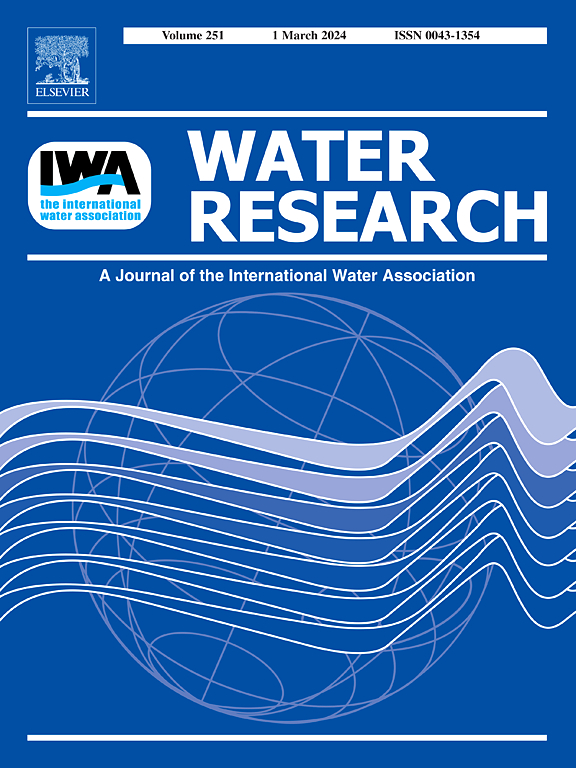利用自适应参数化物理信息神经网络预测河口水域悬浮浮体大小
IF 12.4
1区 环境科学与生态学
Q1 ENGINEERING, ENVIRONMENTAL
引用次数: 0
摘要
细粒泥沙絮凝体的粒径动态在河口水域输沙过程和生态功能中起着基础性作用。然而,传统的絮凝动力学模型通常依赖于固定的经验参数,限制了其在复杂水动力条件下的适应性,降低了预测精度。本文提出了一种新的自适应参数化物理信息神经网络(SAP-PINNs)模型,动态优化絮凝动力学方程中的聚集系数、破碎系数和侵蚀参数,通过将数据驱动方法与物理约束相结合,提高絮凝粒径预测的准确性和物理一致性。实验室实验表明,该模型在低剪切应力条件下校准,准确预测了高剪切应力下的平均絮体尺寸,证实了其在可变水动力条件下的稳健性。现场验证进一步表明,与传统模型相比,该模型的预测性能有了显著提高,准确率提高了88.31%,决定系数为0.99,平均绝对误差为0.78。SHapley加性解释(SHapley Additive explanation, SHAP)分析表明,剪切应力和盐度是影响絮凝的主要因素,悬沙浓度在最佳范围内具有促进絮凝的作用。温度的影响相对较小。该研究表明,SAP-PINNs有效地将物理定律与机器学习技术相结合,提高了絮体动力学的建模精度、可解释性和泛化性。它在复杂的水动力系统、支持河口和沿海水域的泥沙运移预测、生态评估和水质管理方面具有新的应用前景。本文章由计算机程序翻译,如有差异,请以英文原文为准。
Predicting suspended floc size in estuarine waters using self-adaptive parameterized physics-informed neural networks
The size dynamics of suspended flocs play fundamental roles in sediment transport processes and ecological functioning in estuarine waters. However, conventional flocculation dynamic models typically rely on fixed empirical parameters, limiting their adaptability under complex hydrodynamic conditions and reducing predictive accuracy. This study presents a new self-adaptive parameterized physics-informed neural networks (SAP-PINNs) model, dynamically optimizing aggregation coefficient, breakage coefficient and erosion parameters within the flocculation dynamic equation, enhancing the accuracy and physical consistency of floc size predictions by integrating data-driven methodologies with physical constraints. Laboratory experiments demonstrate that the model, calibrated under low shear stress conditions, accurately predicts mean floc size under high shear stress, confirming its robustness across variable hydrodynamic regimes. Field validations further indicate a significant improvement in predictive performance compared to traditional models, with an 88.31 % increase in accuracy, a coefficient of determination of 0.99, and a mean absolute error of 0.78. SHapley Additive exPlanations (SHAP) analysis reveals that shear stress and salinity are the dominant factors influencing flocculation, while suspended sediment concentration exhibits a facilitative effect within an optimal range. Temperature exerts a comparatively minor influence. This study demonstrates that the SAP-PINNs effectively combines physical laws with machine learning techniques, improving the modeling accuracy, interpretability, and generalizability of floc dynamics. It offers a new promising potential for application in complex hydrodynamic systems, supporting sediment transport predictions, ecological assessments, and water quality management in estuarine and coastal waters.
求助全文
通过发布文献求助,成功后即可免费获取论文全文。
去求助
来源期刊

Water Research
环境科学-工程:环境
CiteScore
20.80
自引率
9.40%
发文量
1307
审稿时长
38 days
期刊介绍:
Water Research, along with its open access companion journal Water Research X, serves as a platform for publishing original research papers covering various aspects of the science and technology related to the anthropogenic water cycle, water quality, and its management worldwide. The audience targeted by the journal comprises biologists, chemical engineers, chemists, civil engineers, environmental engineers, limnologists, and microbiologists. The scope of the journal include:
•Treatment processes for water and wastewaters (municipal, agricultural, industrial, and on-site treatment), including resource recovery and residuals management;
•Urban hydrology including sewer systems, stormwater management, and green infrastructure;
•Drinking water treatment and distribution;
•Potable and non-potable water reuse;
•Sanitation, public health, and risk assessment;
•Anaerobic digestion, solid and hazardous waste management, including source characterization and the effects and control of leachates and gaseous emissions;
•Contaminants (chemical, microbial, anthropogenic particles such as nanoparticles or microplastics) and related water quality sensing, monitoring, fate, and assessment;
•Anthropogenic impacts on inland, tidal, coastal and urban waters, focusing on surface and ground waters, and point and non-point sources of pollution;
•Environmental restoration, linked to surface water, groundwater and groundwater remediation;
•Analysis of the interfaces between sediments and water, and between water and atmosphere, focusing specifically on anthropogenic impacts;
•Mathematical modelling, systems analysis, machine learning, and beneficial use of big data related to the anthropogenic water cycle;
•Socio-economic, policy, and regulations studies.
 求助内容:
求助内容: 应助结果提醒方式:
应助结果提醒方式:


